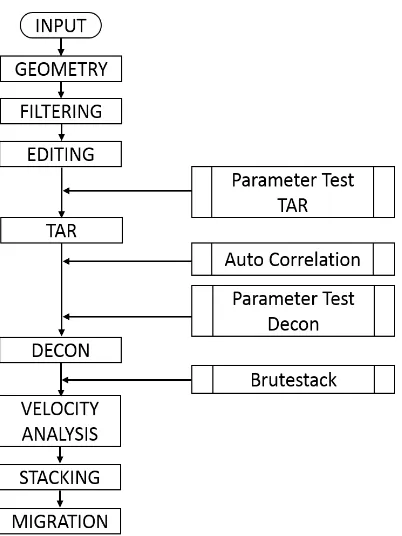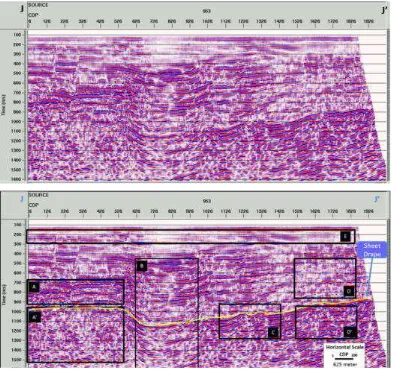* Corresponding author.
Received: 28th August 2016; Revised: 6th September 2016; Accepted: 27th October 2016
ABSTRACT
Two dimensions (2D) seismic profile of Baruna and Jaya lines at North-East Java Basin show seismic reflector characteristics that can be used to interpret sediment thickness and continuity. Those reflector characteristics that can be applied for seismic facies analysis that represents depositional environment. This study starts from seismic data processing that using Kirchhoff Post Stack Time Migration method which is 2D seismic profile as result. Seismic reflector characterization has been done to both 2D profiles. Seismic reflector characterization was grouped as (i) individual reflection, (ii) reflection configuration, (iii) reflection termination, (iv) external form. Individual reflection characteristics show high and medium amplitude, medium and low frequency, and continuous. Configuration reflection is continuous with parallel and subparallel type. Reflection termination shows on lap, and external form shows sheet drape. Local mound appearance can be interpreted as paleo-reef. Facies seismic analysis result for this study area is a shelf.
Keywords: Seismic facies; reflector; Kirchhoff; Post Stack Time Migration
Introduction
The 2D seismic profile is used to determine the subsurface condition in land and seafloor. It can be applied to any major of research not only in oil and gas exploration, e.g. geohazard, paleoenvironment, and continental shelf delineation. The 2D seismic profile contains seismic reflectors that represent physical characteristics of subsurface lithology. Those characters can be grouped as a unit which is called seismic facies.1-2
Seismic facies analysis shows sediment type, process, and stratigraphy which are the result of geometry and reflection configuration interpretation. This paper discusses the interpretation of seismic reflector attributes and seismic facies analysis in 2D seismic reflection profile to determine sedimentation process and
deposition environment in study area.
Methods
This study was started by seismic data processing that SEG-D format. This data was collected using R/V Baruna Jaya II that owned by Agency for the Assessment and Application of Technology (Badan Pengkajian dan Penerapan Teknologi/ BPPT). Seismic data processing used a software named ProMAX version 5000 with Kirchoff Post Stack Time Migration method (Figure 1).3-6
Data processing was done to 2 (two) seismic lines, they are “Baruna” as inline and “Jaya”as crossline. Both of them located at north Madura Island (Figure 2). The long line
of “Baruna” is 3200 CDP (20 km) and
Two-Way Times (TWT) 1000 ms. The long line of
“Jaya” is 2000 CDP (13 km) and TWT 1600
Figure 1. Seismic 2D Data Processing Flow Diagram
Figure 2. Location
Seismic facies analysis was done by seismic facies characterization in migrated 2D seismic reflection profile. Those characterizations involve7-12:
1. Individual reflector: amplitude and frequency characteristics, reflectors continuity. Individual reflector represents density, horizon continuity, horizon thickness, and the depositional process of each lithology.
2. Reflection termination: showing the sequence boundary type based on strata termination. Reflection termination is interpreted as stratification form and uses
sequence, interpret depositional environment, lithofacies estimation. 3. Reflection configuration: gross form
stratification of depositional process, erosion, and paleo topography. Reflection configuration shows stratification pattern, depositional process, erosion, and paleo- topography.
4. External form: geometry pattern from reflection configuration. External form shows depositional form, sediment source, and geological setting.
The depositional environment can be determined as land (alluvial fan, fluvial, lake, desert, swamp), transition (delta, beach, lagoon, tidal flat), marine (reef, continental shelf, continental slope and rise, abyssal plain)13 (Figure 3).14
Result and Discussion
Reflector characteristics of 2D seismic profile in Baruna and Jaya line are:
1. Baruna Line (Figure 4)
Individual reflector characteristics in this profile show continuous reflection - high amplitude - low frequency (A), medium amplitude–high frequency (B). Reflection termination show parallel even (A and B), subparallel and hummocky (C). There is an interlayer between sub-parallel and hummocky (XYZ, C) and fault as a vertical boundary in eastern. On lap, as configuration reflection appears between
Facies seismic analysis brings this study to paleocurrent interpretation which is a process of sediment supply in its paleoenvironment. Sediment supply relies heavily on currents energy. If the current energy is low, so the sediments are fine grain which are showed by box A and B in Baruna
younger strata, which the older is more dip than younger strata (B)
• local mound appearance can be interpreted as paleo reef (C). It represents low sediment supply at that time
• a changing of amplitude from strong amplitude (D’) to medium amplitude (D). it shows lithology changing from coarse grain to fine grain
Figure 5.2D Seismic Reflection of Jaya Line Profile Depositional environment interpretation
that was done to seismic facies unit in Baruna and Jaya profile based on seismic facies parameters, consists of reflection configuration, geometry and structure, literal relation, nature boundary, amplitude, continuity, and frequency. Seismic facies in this study show:
• reflection configuration is dominated by parallel
• sheet drape geometry shows stable condition and fault is rare
• the local mound is carbonate
• concordance and on lap are nature boundary
• high amplitude domination • continuous reflector
• high frequency and not various
Conclusion
1. Seismic data processing use Kirchhoff Post Stack Time Migration method can be applied for seismic facies analysis. 2. In this study, seismic reflector
characteristics that have been found are: a. individual reflector: medium to
strong amplitude, low to medium frequency, continuous reflection b. reflection termination: parallel and
hummocky
c. reflection configuration: on lap (Baruna line)
d. external form: sheet drape and local mound (Jaya line)
References
1. Boggs, S.Jr.Principles of Sedimentology and Stratigraphy, 4th Ed.New Jersey: Pearson Prentice Hall; 2009.
2. R. G. Walker and N. P. James (eds). Facies Models. Response to Sea Level Change.2nd ed. Canada: Geological Association of Canada; 1992.
3. Munadi, S. Pengolahan Data Seismik: Prinsip Dasar dan Metodologi. Depok: Percetakan Universitas Indonesia, Indonesia; 2002.
4. Yilmaz, O. Seismic Data Processing, Society of Exploration Geophysicists, Investigations in Geophysics No. 2. Tulsa, Society of Exploration Geophysics; 1987. 5. Schneider W.A.Integral Formulation for
Migration in Two and Three Dimensions. Geophysics. 1978 Feb; 13(I),19-76.
6. Bancroft, J. C.A Practical Understanding of Pre- and Poststack Migrations, Volume I.Tulsa: Society of Exploration Geophysicist; 1997.
7. Mitchum, R.M,VailP.R., and Thompson S. Seismic stratigraphy and global changes in sealevel, Part 2: The depositional sequence as a basic unit for stratigraphic analysis. In: Payton (Ed.),
10. Sangree, J.B and Widmier J.M. Seismic stratigraphy and global changes in sealevel Part 9: seismic interpretation of clastic depositional facies. In: Payton (Ed.), Seismic Stratigraphy: Application to Hydrocarbon Exploration, AAPG-Memoir No. 26, AAPG, Tulsa; 1977. p. 165–184.
11. Vail, P.R., Todd R. G., and Sangree J. B. Seismic Stratigraphy and Global Changes of Sea Level: Part 5. Chronostratigraphic Significance of Seismic Reflections: Section 2. Application of Seismic Reflection Configuration to Stratigraphic Interpretation. AAPG Memoir 26; 1977. p. 99 – 116.
12. Veeken P.C.H.Seismic Stratigraphy and Depositional Facies Model. Amsterdam: Academic Press; 2013.
13. Nicholas G. Sedimentology and Stratigraphy. UK: Wiley-Blackwell; 2009.


